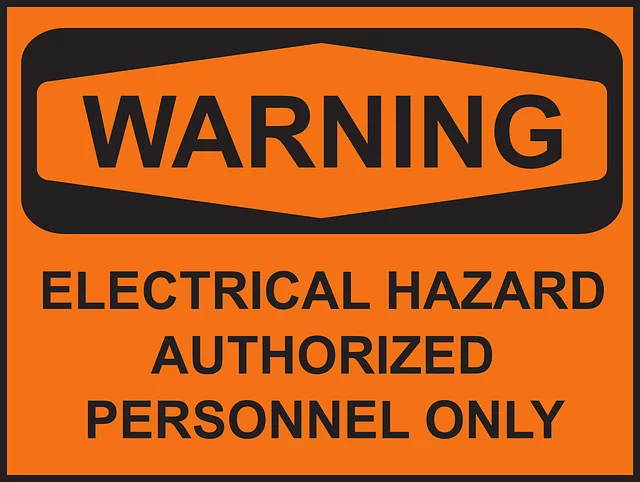Arc flash hazard analysis is a comprehensive process that identifies and mitigates risks associated with electrical systems, quantifying hazards through equipment ratings, energy levels, maintenance practices, and human factors. This knowledge guides the implementation of effective safety measures like protective devices, personal protective equipment (PPE), training protocols, and lockout/tagout procedures, ensuring electrical safety compliance and a safer working environment. Regular equipment maintenance, testing, and employee training are critical components in reducing arc flash risks, with regulatory standards like OSHA and IEC providing guidelines to maintain system integrity and protect employees.
In today’s industrial landscape, understanding and mitigating arc flash hazards are paramount for ensuring electrical safety. This comprehensive guide delves into the critical importance of lockout/tagout procedures in preventing catastrophic arc flash incidents. We explore essential aspects such as arc flash hazard analysis, identifying high-risk areas, and best practices for risk reduction. By adhering to regulatory standards and implementing robust training programs, organizations can foster a culture of electrical safety compliance, ultimately safeguarding personnel and equipment from potential dangers associated with arc flashes.
- Understanding Arc Flash Hazard Analysis: Unveiling the Potential Risks
- The Role of Lockout/Tagout Procedures in Electrical Safety Compliance
- Identifying and Mitigating Sources of Arc Flash Hazards
- Best Practices for Implementing Effective Arc Flash Risk Reduction Strategies
- Equipment Maintenance and Testing for Enhanced Arc Flash Safety
- Training Employees: Fostering a Culture of Electrical Safety Awareness
- Regulatory Standards and Their Impact on Arc Flash Protection
Understanding Arc Flash Hazard Analysis: Unveiling the Potential Risks

Understanding Arc Flash Hazard Analysis: Unveiling the Potential Risks
Arc flash hazard analysis is a critical step in identifying and mitigating potential risks associated with electrical systems. It involves a thorough assessment of an electrical system’s design, operation, and maintenance to determine the likelihood and magnitude of an arc flash event. This process helps to quantify the hazards present and guide decisions on appropriate risk reduction measures. By conducting a detailed analysis, organizations can ensure electrical safety compliance and implement effective strategies for arc flash risk reduction.
This analysis should consider various factors such as equipment ratings, energy levels, maintenance practices, and human factors. By understanding these elements, professionals can accurately predict the consequences of an arc flash incident, ranging from severe burns to equipment damage or even explosions. Armed with this knowledge, they can make informed choices about protective devices, personal protective equipment (PPE), training protocols, and other safety measures needed to create a safer working environment.
The Role of Lockout/Tagout Procedures in Electrical Safety Compliance

Lockout/tagout procedures play a pivotal role in ensuring electrical safety compliance and mitigating arc flash hazards. These critical protocols involve de-energizing and securing electrical equipment before maintenance or work activities are initiated. By implementing effective lockout/tagout practices, organizations can significantly reduce the risks associated with arc flashes, which are potentially devastating electrical events.
An arc flash risk reduction strategy should encompass a comprehensive arc flash hazard analysis to identify high-risk areas and tasks. Once hazards are identified, proper lockout/tagout procedures are implemented, ensuring that all personnel involved are aware of their responsibilities. This includes using specialized tags to clearly indicate de-energized equipment, preventing accidental activation, and fostering a culture of safety awareness throughout the workplace.
Identifying and Mitigating Sources of Arc Flash Hazards

Identifying and mitigating sources of arc flash hazards is a critical step in ensuring electrical safety compliance. An arc flash hazard analysis involves thoroughly examining work areas, equipment, and processes to pinpoint potential triggers for an arc flash event. This includes assessing high-voltage systems, loose connections, damaged insulation, and improper grounding. Once these sources are identified, targeted strategies can be implemented to reduce the associated risks.
Effective risk reduction measures involve a combination of administrative controls, engineering solutions, and personal protective equipment (PPE). Administrative controls, such as proper training and work practices, play a vital role in minimizing exposure. Engineering solutions, like automated processes or remote control systems, further lessen the chances of accidental arc flash occurrences. Additionally, selecting appropriate PPE, such as arc flash-rated clothing, ensures that workers are protected when performing tasks near live electrical equipment.
Best Practices for Implementing Effective Arc Flash Risk Reduction Strategies

When implementing effective arc flash risk reduction strategies, a comprehensive approach is essential. Start by conducting an arc flash hazard analysis to identify potential risks and determine appropriate control measures. This involves assessing electrical systems, equipment, and work practices to pinpoint areas where arcing could occur and cause harm. Once identified, implement hierarchy of controls, prioritizing safety measures like de-energization, protective equipment, and engineering controls.
Best practices also include regular maintenance and inspection of electrical systems to ensure they meet electrical safety compliance standards. Regular training for workers involved in high-risk tasks is crucial, ensuring they understand arc flash hazards and know how to respond safely. Consistent use of proper personal protective equipment (PPE), such as arc flash suits and safety glasses, is equally vital. Lastly, establish clear protocols for lockout/tagout procedures to prevent unauthorized activation during maintenance or repair work.
Equipment Maintenance and Testing for Enhanced Arc Flash Safety

Regular equipment maintenance and testing are vital components of an effective Arc Flash Risk Reduction strategy. A comprehensive arc flash hazard analysis should be conducted to identify potential risks associated with electrical systems, followed by implementing preventive measures. This includes routine inspections to ensure all protective devices, such as circuit breakers and relays, operate correctly and are in compliance with electrical safety standards.
Testing procedures like insulation resistance testing and ground resistance testing help maintain the integrity of electrical equipment. By regularly calibrating and maintaining instruments used for these tests, organizations can enhance their arc flash safety performance. These proactive steps not only mitigate the arc flash hazard but also ensure continuous electrical safety compliance, safeguarding workers and facilities from potentially catastrophic incidents.
Training Employees: Fostering a Culture of Electrical Safety Awareness

Training employees is a fundamental aspect of fostering a culture of electrical safety awareness. It involves equipping workers with the knowledge and skills to identify, understand, and mitigate arc flash hazards effectively. By conducting regular arc flash hazard analyses, employers can pinpoint potential risks associated with electrical systems within their facilities. This process helps in implementing tailored strategies for arc flash risk reduction, ensuring electrical safety compliance.
Through comprehensive training programs, employees learn proper lockout/tagout procedures, safe work practices, and the use of personal protective equipment (PPE). These measures create a proactive approach to electrical safety, where every individual takes responsibility for their actions and the well-being of their colleagues, ultimately minimizing the likelihood and severity of arc flash incidents.
Regulatory Standards and Their Impact on Arc Flash Protection

In the realm of electrical safety, regulatory standards play a pivotal role in safeguarding workers from the formidable arc flash hazard. These standards, such as those set by OSHA (Occupational Safety and Health Administration) and IEC (International Electrotechnical Commission), mandate specific procedures for lockout/tagout systems, ensuring that electrical equipment is de-energized and isolated before maintenance or repair. Compliance with these regulations is not merely a legal requirement but also a critical step in arc flash risk reduction. By implementing robust lockout/tagout practices, organizations can significantly mitigate the potential for arc flashes, which can cause severe burns, blindness, and even fatalities.
An arc flash hazard analysis forms the backbone of effective electrical safety compliance. This process involves identifying potential sources of arc flash hazards within the workplace, evaluating the associated risks, and implementing corresponding control measures. Through such analyses, employers can pinpoint areas where lockout/tagout procedures are most crucial and tailor their safety protocols accordingly. By prioritizing arc flash risk reduction, organizations not only safeguard their employees but also maintain electrical system integrity and comply with industry best practices.


